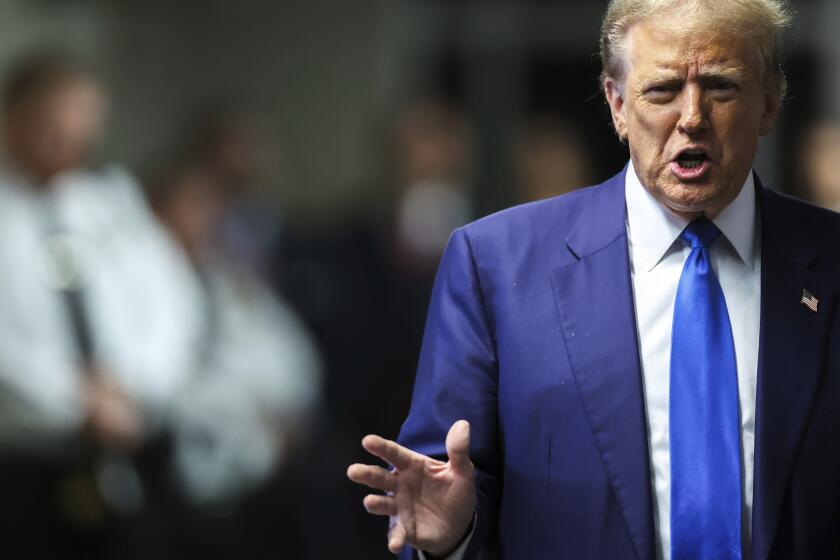Shift by Fed May Prevent Taxes From Being Raised
Federal Reserve Board Chairman Alan Greenspan has admitted in congressional testimony that the credit crunch--previously claimed by the Fed to be nonexistent--is serious enough to warrant some monetary ease. In so doing, he may have prevented Congress and the Administration from introducing a level of fiscal restraint that would have driven the U.S. economy right into the mud.
The Fed shift could also prompt Congress to rethink its position on new taxes, reasoning that if the Fed--which has been maintaining firm credit to fight inflation--is suddenly more concerned about the health of the economy, this is no time to depress things further by raising taxes and cutting federal outlays.
Greenspan is no doubt worried about progressive weakness in interest-sensitive sectors of the economy, but is also under excruciating pressure from the Bush Administration and Republicans in Congress who fret over the depressing economic effects of the ongoing credit crunch and high interest rates, especially in an election year.
The Administration and Congress have also been feeling the weight of the rapidly growing federal deficit. Spending has been soaring even without the savings and loan bailout costs, and that crisis has added additional hefty poundage to outlays. Furthermore, the softening economy has cut revenue, especially corporate income taxes.
The growing deficit raises the specter of huge Gramm-Rudman-required spending cuts. The automatic spending cuts needed to get from a $232-billion deficit to a $74-billion deficit would devastate the pet programs of both Congress and the Administration. Any deficit reduction program that would avoid the chaos of those spending slashes would be most welcome.
Moreover, despite the pressure to reduce the deficit, Washington just doesn’t have a habit of raising taxes--especially individual income taxes--or cutting spending in election years. There are lots or reasons to suspect, then, that there will be no meaningful deficit-reduction measures enacted, at least not this year.
But, you’re thinking, then the Gramm-Rudman spending cuts would be automatic, and Washington can’t stand by and watch about $150 billion hacked out of favorite programs. There are, however, escape clauses in the Gramm-Rudman law that might come into play and rescue the lawmakers and the President.
If real gross national product is reported to have grown less than 1% at annual rates for two consecutive quarters, or if the Administration estimates that real GNP will decline for two consecutive quarters, then Congress can pass, and the President can sign, a joint resolution suspending Gramm-Rudman.
Treasury Secretary Nicholas F. Brady--although still arguing that the United States can avoid a recession--recently said the Middle East crisis could cut the real economic growth rate to 0.75% in the second half of this year. Iraq’s invasion of Kuwait gives the Administration another reason to suspend Gramm-Rudman. The Administration has already exercised its option--citing national security--to exempt military personnel accounts from any across-the-board spending cuts this year.
An unlikely alternative would be for Congress and the Administration to actually raise taxes and cut spending to the tune of the $50 billion they’ve been discussing, despite all the drawbacks. This would be far and away the biggest package of fiscal restraint in U.S. history, but would still not bring a projected deficit of more than $200 billion in fiscal 1991 down to the required $74-billion level. And, that $200-billion-plus figure would be a gross underestimate if, as I expect, the U.S. economy is already in a recession.
Based on the experience of postwar recessions, an average downturn would increase the current deficit by $125 billion--bringing it close to $300 billion--even if taxes were not cut or real spending increased in response to business weakness. With a deep recession, the red ink could reach $350 billion or even $400 billion.
Congress has experience dealing with such huge gaps between projected deficits and Gramm-Rudman requirements--they simply change the law. There is already agreement by both Republicans and Democrats to remove the huge S&L; bailout costs from the budget and to also exclude the large surpluses piling up in the Social Security trust fund. The Middle East conflict could provide the rationale to exempt defense spending from deficit ceilings.
Although far short of the amount of fiscal restraint required by the current Gramm-Rudman law, $50 billion or perhaps even less in spending cuts might be enough to turn an unfolding recession into something considerably deeper. Even though the Fed would be easing credit in response to genuine fiscal restraint, and later dumping money out of airplanes to counteract financial crises and a serious recession, the monetary authorities’ actions, as usual, would come too late to arrest the bulk of the downward course of business.
This prospect is intensified by the similarities between today’s world and that of the early 1930s. Then, as now, the debt-ridden consumer was paying the price of years of growth, available credit had dried up, foreign debtors were struggling to service their loans, the Fed was worried about inflation and the Administration was concerned about a growing budget deficit.
In the early years of the Depression, both the Administration and the Fed responded with appropriate stimulating measures: President Herbert Hoover and Congress agreed on a temporary tax cut, Hoover persuaded major businesses to maintain current wage levels (Henry Ford actually raised wages from his celebrated $5 a day to $7 a day) and the Fed cut the discount rate.
However, by 1931, businesses could no longer maintain their wage promises, and the budget was running a $1-billion deficit. The tax cut of 1929 was not renewed, and tax rates returned to their original levels. In June, 1932, only weeks before the Democratic and Republican national conventions (both parties’ presidential candidates were calling for a balanced budget), Congress and Hoover agreed on a new tax proposal. That more than doubled the basic income tax rates, increased other taxes and reduced exemptions.
This fiscal policy certainly didn’t eliminate the deficit, which jumped to $3.3 billion in 1934 from $2.6 billion in 1933. At the same time, the economy’s slide accelerated, the fall in real GNP going from an annual decline of 6.6% between the third quarter of 1930 and the third quarter of 1931, to an annualized drop of 15% from the third quarter of 1931 to the same quarter of 1933.
A tax increase now could result in a sequel to the 1930s--a classic case of the wrong policy at the wrong time. Fortunately, both Congress and the Administration have a few ways to get around imposing one.
More to Read
Get the L.A. Times Politics newsletter
Deeply reported insights into legislation, politics and policy from Sacramento, Washington and beyond. In your inbox three times per week.
You may occasionally receive promotional content from the Los Angeles Times.






